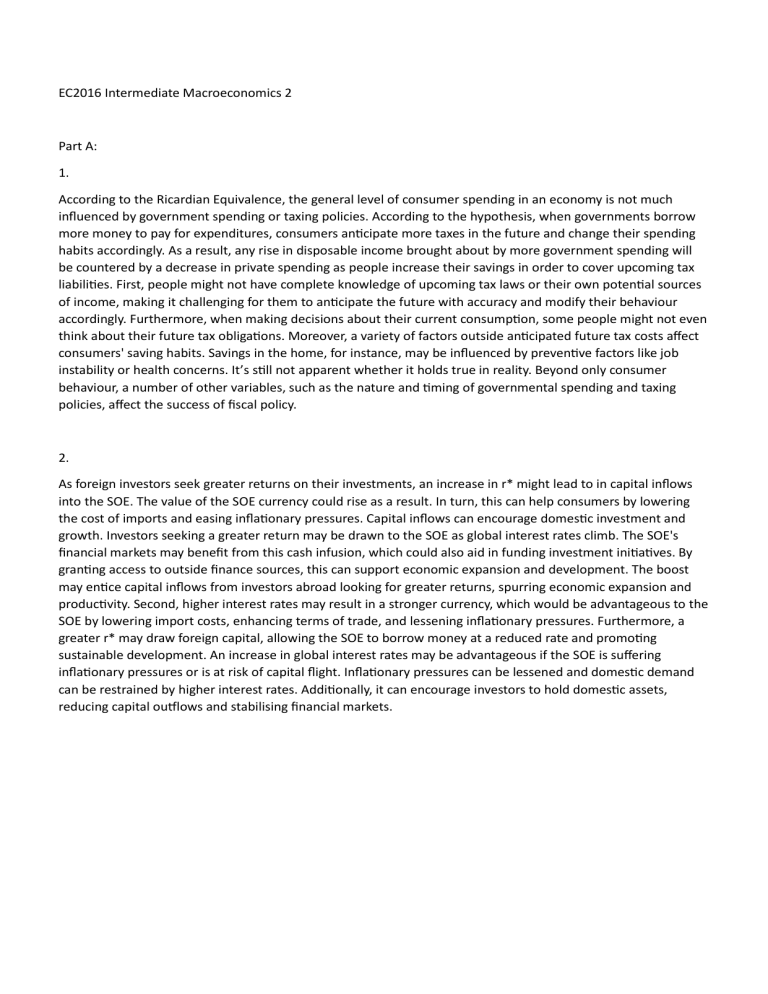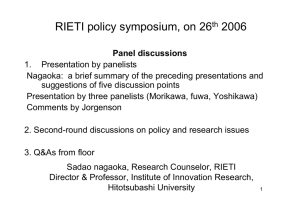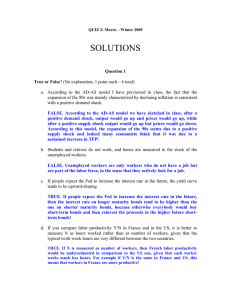
EC2016 Intermediate Macroeconomics 2 Part A: 1. According to the Ricardian Equivalence, the general level of consumer spending in an economy is not much influenced by government spending or taxing policies. According to the hypothesis, when governments borrow more money to pay for expenditures, consumers anticipate more taxes in the future and change their spending habits accordingly. As a result, any rise in disposable income brought about by more government spending will be countered by a decrease in private spending as people increase their savings in order to cover upcoming tax liabilities. First, people might not have complete knowledge of upcoming tax laws or their own potential sources of income, making it challenging for them to anticipate the future with accuracy and modify their behaviour accordingly. Furthermore, when making decisions about their current consumption, some people might not even think about their future tax obligations. Moreover, a variety of factors outside anticipated future tax costs affect consumers' saving habits. Savings in the home, for instance, may be influenced by preventive factors like job instability or health concerns. It’s still not apparent whether it holds true in reality. Beyond only consumer behaviour, a number of other variables, such as the nature and timing of governmental spending and taxing policies, affect the success of fiscal policy. 2. As foreign investors seek greater returns on their investments, an increase in r* might lead to in capital inflows into the SOE. The value of the SOE currency could rise as a result. In turn, this can help consumers by lowering the cost of imports and easing inflationary pressures. Capital inflows can encourage domestic investment and growth. Investors seeking a greater return may be drawn to the SOE as global interest rates climb. The SOE's financial markets may benefit from this cash infusion, which could also aid in funding investment initiatives. By granting access to outside finance sources, this can support economic expansion and development. The boost may entice capital inflows from investors abroad looking for greater returns, spurring economic expansion and productivity. Second, higher interest rates may result in a stronger currency, which would be advantageous to the SOE by lowering import costs, enhancing terms of trade, and lessening inflationary pressures. Furthermore, a greater r* may draw foreign capital, allowing the SOE to borrow money at a reduced rate and promoting sustainable development. An increase in global interest rates may be advantageous if the SOE is suffering inflationary pressures or is at risk of capital flight. Inflationary pressures can be lessened and domestic demand can be restrained by higher interest rates. Additionally, it can encourage investors to hold domestic assets, reducing capital outflows and stabilising financial markets. 3. Macroeconomics places more emphasis on the overall health of the economy than it does on specific measures used by governments to censor the media. However, if a government were to support such a claim, it might do so on the grounds of preserving stability and averting unfavourable economic effects. A critical publication may be closed, the government may claim, in order to protect investor confidence and economic stability. They would contend that unfavourable press coverage can damage investor confidence, which would therefore discourage investment and economic activity and ultimately hurt the economy. The goal of the government is to uphold a favourable reputation, draw in investment, and foster economic progress. They can contend that safeguarding national interests and averting destabilising forces falls under their competence. Despite the fact that investor confidence is not completely based on favourable media coverage, the argument for closing down a critical newspaper based on macroeconomic theory can be refuted by the reality that macroeconomic stability is indeed a crucial factor. Investors take into account a wide range of variables, including institutional strength, political stability, the rule of law, and economic fundamentals. Suppression of dissenting voices could lead people to question the government's adherence to democratic values and openness, which would eventually erode public confidence. A rich marketplace of ideas is fostered by a diverse media environment that allows for the expression of many viewpoints. This diversity may result in novel ideas, better policies, and sounder economic judgement. Limiting critical voices reduces the variety of thoughts and viewpoints available, potentially inhibiting innovation and obstructing growth. 5. The Solow growth model was important because it offered a framework for comprehending long-term economic growth. It was created in the 1950s. The diminishing returns to capital accumulation anticipated that countries with lower income levels would have quicker rates of growth. In the 1980s and 1990s, academics noticed that some nations were maintaining rapid rates of economic growth despite having comparable levels of physical capital as other nations. This led them to develop the endogenous growth model. As a result, theories were created that highlighted the contribution of innovation, human capital, and technology to economic progress. The two models are primarily distinguished by how they handle technological advancement. In contrast to endogenous growth models, which place emphasis on the function of policies like research and development subsidies or educational programmes in supporting technological progress, the Solow model posits that technological progress is exogenous and cannot be controlled by policy. a. A macroeconomic model called the Real Business Cycle Model (RBC) holds that changes in total factor productivity (TFP) are what cause changes in output, employment, and other economic indicators. A brief but sustained increase in TFP would result in an upward change in the production function curve in this closed economy. when a result, when businesses generate more goods and services with their current resources, current output would rise. As businesses look to create more output, there would be an increase in demand for labour with a rise in TFP. The labour demand curve would be shifted upward as a result of this. As more employees are hired to fulfil the rising demand for labour, current employment levels will increase. Investment is a function of projected future earnings, thus it is likely to rise as a result of the TFP shock's greater predicted future productivity. The investment demand curve is shifted upward as a result. Consequently, existing investment levels will rise. The meeting point of the labour supply and demand curves determines real wages. Real wages will rise together with the upward change in the labour demand curve brought on by increased TFP as employees become more productive and consequently earn higher wages. Prices would go down because of lower production unit costs brought on by increased productivity levels brought on by the TFP shock. The price level or aggregate supply curve will shift lower, which suggests that prices are falling even as output rises. Finally, due to increased anticipated future returns on capital investments following the TFP shock, present real interest rates will decline. An upward change in the production function implies an increase in the capital's marginal product, which lowers the cost of capital and lowers real interest rates. Overall, these adjustments show that an economy can benefit from changes like enhanced TFP, which boost employment rates, GDP growth rates, and inflation rates while lowering real interest rates, following the occurrence of a brief but lasting shock. As a result, the Real Business Cycle Model demonstrates how numerous areas of the economy can be significantly impacted by a transient but sustained spike in TFP. How this shock impacts current employment, output, investment, real wages, prices, and real interest rates is shown graphically in the analysis. Increased output and employment result from an upward shift in the production function, and as prices decline because of more supply, inflation is also reduced. Higher predicted future returns on capital investments also translate into lower capital expenditures, which in turn results in lower real interest rates. Overall, these adjustments imply that favourable economic outcomes are still attainable even in the face of transient shocks like an increase in TFP. b. We still see variations in total factor productivity (TFP) in closed economies. TFP assesses how effectively inputs are used to produce output and reflects advancements in technology. It is determined as the output to input ratio, with labour, capital, and intermediate inputs being the inputs. The two elements of TFP growth are technological change and efficiency change. Efficiency change captures the results of businesses' attempts to use resources more effectively, whereas technical change represents advancements in technology. There are several methods for calculating TFP growth. The Solow residual approach, which estimates a production function that connects output to inputs and then uses the residuals as a measure of TFP growth, is one popular technique. Growth accounting is a different approach that breaks down output growth into contributions from labour, capital, and TFP. Finally, there are econometric techniques that calculate TFP directly from input and output data. Overall, keeping an eye on TFP fluctuations is crucial for comprehending long-term economic growth and finding areas where resource allocation and technical advancement can be improved. c. Changes in TFP (Total Factor Productivity), which affect the economy's growth rate over time, are thought to be persistent in closed economies. The economy is growing more effective at generating goods and services with the same number of inputs while TFP is increasing. Higher output and earnings for businesses result from this, which motivates them to invest and increase their production capacity. As businesses grow, they increase staff and invest in new gear and equipment, which boosts the economy's capital stock. Additional productivity improvements and economic expansion follow from this. These advantages would soon disappear as enterprises returned to their prior level of productivity, though, if TFP were not permanent. Changes in TFP can also result in breakthroughs and technological advancements that have a long-term effect on the economy's productive capacity. These can include brand-new techniques for producing goods as well as cutting-edge technologies that allow for the emergence of completely new industries. d. In response to a brief rise in total factor productivity, the average productivity of labour and employment is predicted to behave differently by the Real Business Cycles Model and the Coordination Failure Model. Current TFP shocks and current average labour and employment productivity have a positive correlation in the RBC model but a negative correlation in the Coordination Failure model. These predictions match actual data, and we discover that both models have advantages and disadvantages of their own. Although the RBC model does a decent job of explaining short-term changes in output and employment, it is unable to consider long-term trends like productivity increase. The Coordination Failure model, on the other hand, helps to explain persistent unemployment but has trouble explaining quick economic recovery following recessions. Overall, when examining economic occurrences, it is crucial to consider both models. Even though they might make various predictions, they all provide insightful information about the intricate dynamics of the economy.




